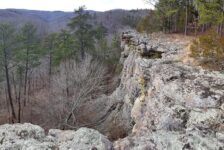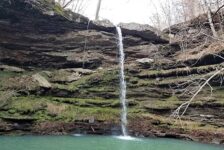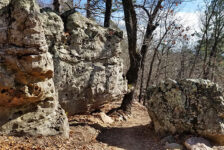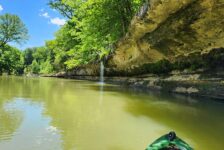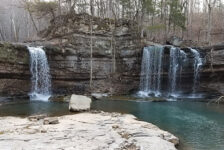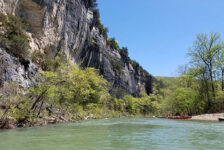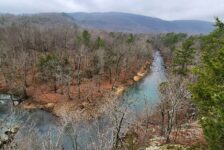
The Buffalo River will be open again for camping effective May 29, 2020. This is great news for the paddling community! But you can rest assured that the campgrounds around the Buffalo will be full this weekend. Even if you can get a spot, if you’re concerned about social distancing, that might be kind of difficult in the campgrounds. Have you ever considered an overnight camping float on the Buffalo River? There are miles and miles of gravel bars to camp on, far away from anyone else. Packing your gear can be tricky. But once you’re packed and on the water, you’re free to stop wherever you want to spend the night. No schedule, no late pickups. You get your choice of the perfect riverbank to camp on, most of which are nicer than the campgrounds!
My first overnight float on the Buffalo River was a few years ago, from Pruitt to Carver. I had seen so many others doing this over the years and was always a little jealous of them. I’m not a huge fan of most of the campgrounds along the upper Buffalo. Many of the tree-covered gravel bars along the river always seemed like a better option to me. So when I finally found a crew to do this with me, ohhh buddy…it was on!!! If you have not camped out on the banks of the Buffalo, but have ever wanted to, keep reading.
Directions
Obviously, you can overnight float any section of the river that has enough water. But if you are interested in this particular float, the put-in and take-out points are mapped for you below. Since some of our crew was renting, we got shuttled by an outfitter out of Jasper, and they picked us up the next day. If you want to self-shuttle this float though, it shouldn’t be too hard.
What to Expect
The River
All sections of the Buffalo River have plenty to offer, and this section is no different. This is getting into the middle section of the river – Upper-Middle, if you will. The Upper Buffalo is known for it’s huge bluffs, waterfalls, and it’s big, fast rapids. And most people think of the Lower Buffalo as a little bit slower water, not quite as many towering bluffs, but still very beautiful. The Middle Buffalo gives you a little bit of both. It still has lots of really high bluffs and trails to some waterfalls. And you’ll find some river-level caves. The rapids may not be as big and fast as the upper sections, but there’s still a lot of fast current and fun rapids here.
Just like all sections of the Buffalo, the scenery on this float is top-notch. And the fishing on this part of the river isn’t bad either. We could have chosen a longer float to do for an over-nighter. But part of our crew needed to get home early that Sunday so we picked a closer take-out for them. We also wanted to stop early on Day one to set up camp and just hang out. So a shorter overnight float suited us just fine. Here are some pics of this section of the river.
Gravel Bar Camping
One of the best things about camping on the river is the flexibility it brings to your float. You don’t have to worry about getting to a certain point or campground on time. And you don’t have to shuttle back to your car or drive anywhere that day. When you’re ready to stop and camp, you stop when you see a place you like. The cool thing is that you’re not likely to find a really great spot that hasn’t already been camped on. So when you think you’ve found that “perfect spot”, there’s good chance someone has already prepared it for you.
Everyone in my crew was geared for hammock camping. So we wanted to find a gravel bar with trees, close to the water. When we found our perfect spot to camp, it was clear that others before us had shared the same opinion. We found a nice fire ring already built and placed exactly where we wanted it. There were plenty of trees for all our hammocks, and to provide us some shade. We set up quickly and were able to find plenty of firewood. We even got in a little fishing that evening. Once we got our fire built, it was time for steak and foil-pack potatoes, followed by beers and lots of laughs by the fire.
Our trip was in early April, so it was pretty chilly that night. But a 20-degree sleeping bag in my hammock was perfect. And the sound of the rushing water nearby made for some great sleeping. I didn’t want to get out of that bag in the morning. But I couldn’t resist the lure of coffee and breakfast by the river. The worst part of this trip was having to pack up that campsite and leave. I could have stayed there for days. Here are some pics from our camp.
Plan Your Trip
The most important thing about planning an overnight float on the Buffalo River is choosing a time when it is not going to rain. Being rained on and getting your gear wet sucks, but that’s not the real issue. The big issue is safety. If the Buffalo gets enough rain, it can rise to dangerous levels quickly. It’s one thing for this to happen while you’re paddling. But if it happens while you’re asleep, it can be disastrous and even deadly. It is also important to study the river map to figure out where you will end the float. You can’t rely on cell service on the river. So once you’ve scheduled your shuttle pick-up or dropped off a car there, you have to stick to it!
Now let’s talk about gear. You’ll have to pack your camping gear, food, drinks, and clothes all into your boat. This means there needs to be at least one canoe in your group, or a tow vessel if you’re kayaking. OR…you’re going to have to pack really light. On this trip, we all had canoes. But since then I’ve worked on ways to do this in my kayak. Either way, I recommend using a lot of the same gear that would be used for backpacking. You want things that are light and take up little space. Also, coordinate with your group on things you can share so you don’t double up and waste space. Freeze a dozen water bottles to use as ice in your cooler. They last longer than bagged ice and double as drinking water when they melt. There are lots of hacks you can do to save space.
If you’re not sure of everything you’ll need, start with our gear list and add/delete items to suit your needs. I say this every time, but it’s necessary – NO GLASS ON THE RIVER! Pets, yes. Glass, no. Please be prepared to pack out any trash you have. The river has a ton of visitors from Spring till Fall. We must all do our part to leave no trace and take care of this treasure. Watch the weather and water levels, and be safe out there. See ya on the river!


























